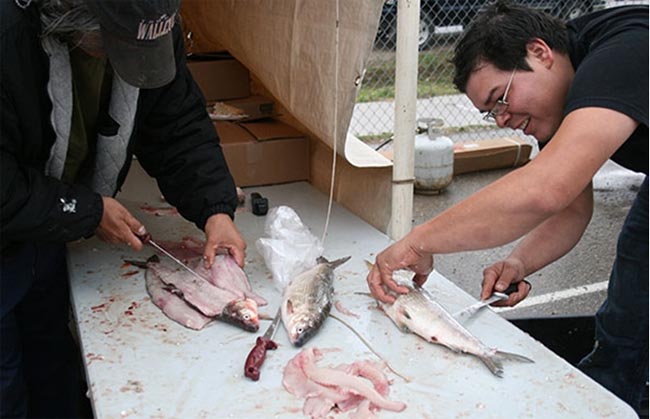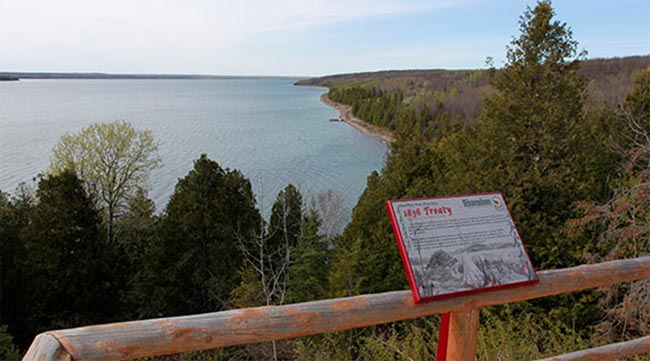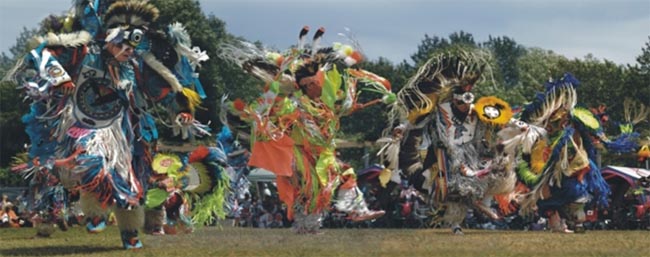Community Profile: Wikwemikong keeping the language alive



By Rick Garrick
Wikwemikong Unceded Indian Reserve has been creating Anishinaabemowin Apps, holding monthly language gatherings and implementing an Anishinaabemowin Literacy block to keep their language alive.
“We supported the development of an Anishinaabemowin language app, which is available on smart phones,” says Wikwemikong Ogimaa Duke Peltier. “It is readily available for many of our young people as well as our adult population, not only in our community but throughout the world.”
Peltier says the Anishinaabemowin App takes advantage of the growing interest in cell phones.
“We do have to follow where our people are — they are very much in tune to new technology,” Peltier says. “Ultimately, the preferred approach would be for them to be visiting with their parents and grandparents and conversing at the kitchen table, but with the fast pace of the world now this is a tool that could be used by those people who are wishing to regain their language.”
Peltier says the Anishinaabemowin App enables community members to converse and interact in their own language as well as gain the basic foundation of the language.
“We’re working on our second Anishinaabemowin App right now,” says Brian Peltier, cultural programmer at Wiikwemkoong Anishinaabewin Bemninzhaandgik (Wikwemikong Heritage Organization). “And also on top of that, we are trying to create an online portal where people can have all the access to language. We can have chat rooms, language classes and they can hear every word we have spoken along with how to use those words in action sequences.”
The first Anishinaabemowin App is available for purchase at iTunes and Google Play for Apple and Android devices for $7.99 each.
“It has over 650 words and phrases,” Brian Peltier says, noting the app also features language quizzes and games. “You could also record yourself and compare it with a fluent speaker.”
Wiikwemkoong Anishinaabewin Bemninzhaandgik also conducts monthly language gatherings with Elders to preserve words and develop new words as the language evolves.
“It is important for young children to have Anishinabemowin as a first language,” Brian Peltier says. “They will be able to see more of the Anishinabe point of view.”
Brian Peltier says fluent speakers account for about 11 per cent of Wikwemikong’s on-reserve population of about 3,500. The Manitoulin Island community has about 7,900 citizens in total.
“But that is one number we have to change,” Brian Peltier says. “We’ve been losing a lot of our fluent speakers, so we need to replace them with new ones. The only way to do that I say is (by starting) with the youngest.”
Wikwemikong has been implementing an Anishinaabemowin Literacy block to increase language skills among about 679 students in the community’s four schools: the Wikwemikong Hub Centre for pre-schoolers and toddlers; the Wasse-Awin Junior School for Grades 1-4; the Pontiac School for Grades 5-8; and the Wikwemikong High School.
The Anishinaabemowin Literacy block aims to provide longer Anishinabemowin classes from Kindergarten to Grade 4; achieve functional Anishinabemowin speakers by the end of Primary/Junior grades; encourage youth to speak Anishinabemowin in daily situations, competitions and conferences; and encourage Anishinabemowin use at home with parents, grandparents, siblings and extended family.
In addition to increasing language skills, the community also expanded its small business centre in 2014 to create a 9,000 square-foot mall with a Your Dollar Store with More franchise as the anchor tenant.
“It’s created employment opportunities within the community,” Chief Peltier says, noting many community members are supporting the mall instead of travelling to neighbouring communities to shop. “It also draws in a number of people from all over Manitoulin Island.”
An Active Living Studio has also been established in the mall for fitness and dance users.
“We’re trying to keep our people healthy as well,” Peltier says, noting the community has been looking at developing a Diabetes Centre of Excellence to provide dialysis and foot-care treatments. “When I came into office, I had support from the council to address diabetes in the community. We’re trying to educate our people about the effects of diabetes.”
Peltier says the community is looking to increase its participation in the forest industry by capitalizing on its assets, such as a share in a sustainable forest licence in the Vermilion Forest in the Sudbury region.
“We’re looking at some of the opportunities that do exist,” Peltier says. “A lot of this forest activity is around the Point Grondine area.”
Point Grondine amalgamated with South Bay and the Manitoulin Island Indian Reserve in 1968 to form the current Wikwemikong Unceded Indian Reserve.
Wikwemikong is also looking to maximize its forest resource imaging business through a $49,500 investment from FedNor.
The community hosts a Traditional Pow Wow in June and an Annual Cultural Festival competition pow wow on the Civic Holiday weekend. In addition, a number of traditional lodges have been re-established in the community.
“It’s just reconnecting with our spirituality, our ceremonies, our teaching lodges,” Brian Peltier says.
Although Wikwemikong was originally an Odawa community, a group of Potawatomi joined the community in 1836 and a group of Ojibwe joined after 1850.
“We all understand each other — we are very sensitive about how the other thinks,” Brian Peltier says. “Rabbit Island is predominantly a strong Odawa area; when you go down to South Bay, that’s where a lot of the Pottowatomi live. And the rest are spread all around the whole reserve, Ojibwe, Pottowatomi and Odawa. So it’s a mixture of three languages.”
Wikwemikong’s citizens have achieved many education goals over the years and now work in communities across North America.
“There are a lot of people who are doctors, dentists, optometrists,” Brian Peltier says. “A lot of them are educators as well — a lot of our fluent speakers teach in a lot of the schools around the United States and the north shore area.”
Wikwemikong is currently negotiating a land claim for the islands off the eastern shore of Manitoulin Island with the federal and provincial governments.


